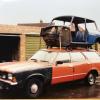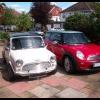With any production engine, especially of that era, there needed to be a fair degree of conservatism applied to any design.
This is to ensure a high degree of reliability, robustness, allow for production tolerances and the ability to recondition the engine (and in that era, it seems at least twice).
In regards to the 1275, originally, the factory only deemed them 'safe' to rebore to +0.020" (with a first at +0.010") and at a quick look through the parts books, this was the case to at least 1986 and likely beyond. I'd say this came down to possible concerns over bore porosity, and head gasket reliability. Keep in mind here too that we are talking about mass production units, not bespoke 1 offs, where much more time and attention usually is given and that couldn't be productionised. While the factory capped that at +0.020", personally and taking production methods in to account, I feel they could have sensibly gone to +0.060" over and that's about it.
Also, the Crankshafts were also only deemed to be grindable to -0.020" on the Mains and -0.040" on the Big Ends.
In production as well, some blocks didn't pass muster and were fitted with liners, so the ability to do that - in their conservative production environment - also needed to be taken in to account.
I know that some 1275's can be taken to just shy of 1600 cc, however, the Production Cylinder Heads just couldn't nearly feed enough Air in to them at that capacity and so at this size, they have next to no HP gains over those at 1500, though, they did have a little more low RPM power. With most 1275 Blocks, once you go above (if I recall) about an 86 mm stroke, you also need to start grinding the block & gearbox to get clearance for the Big Ends. Also, when working from Factory Production Cranks, stroking beyond 0.060" (1.5 mm) over standard, requires the use of different Con Rods (Cooper S & Sprite), however, this is going beyond their safe limit of -0.040.
Also, keep in mind, they wanted to churn out cars for the masses, including some sports models, with as few warranty issues as possible, as that not only cost them money to rectify, but also loss of reputation.
In later years, rather than looking to a bigger engine, they just fitted a blower, and again, in a very conservative way, rather than spend money on effective making a new engine.
All the A Series Engines were machined by Transfer Machines (pre-CNC) and many of the suggestions put forward by the Development Department, while sound in every respect, they often couldn't be machined in their Transfer Machines and so they never say the light of day outside of that department as management, to their peril, wouldn't spend the cash needed to up-date and modernise that production line. I think when the Metro was coming in to play and they looked at what to do with the engine, a golden opportunity was lost then to make this move.



















